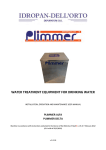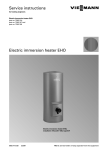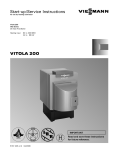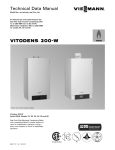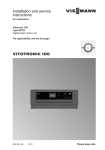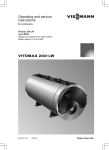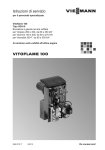Download Viessmann VITOPLEX 100?LS Operating instructions
Transcript
Installation and service instructions for heating engineers Vitoplex100−LS TypeSXD, 0.26 to 0.7 t/h Oil/gas fired boiler Steam generator up to 1bar operating pressure VITOPLEX 100−LS 5692729 GB4/2007 Please keep safe General information Safety instructions Please follow these safety instructions closely to prevent accidents and material losses. In an emergency H Immediately switch OFF emergency stop switch (outside boiler room) (except if you smell gas). H Close the shut−off valves of the main fuel lines. H For fire, use an appropriate fire extinguisher. Work on the equipment Installation, initial start−up, inspection, maintenance and repairs must only be carried out by a competent person (heating engineer/installation contractor). Before working on equipment/ heating system, isolate its mains electrical supply (e.g. by removing a separate mains fuse or by means of a mains electrical isolator) and safeguard against unauthorised reconnection. When using gas as fuel, also close main gas shut−off valve and safeguard against unauthorised reopening. Installation of additional components Installation of additional components which have not been tested together with the boiler can adversely affect the boiler function. Our warranty does not cover and we accept no liability for damage caused by the installation of such components. 2 Boiler room conditions H Do not use where air is polluted with halogenated hydrocarbons (e.g. as in aerosols, paints, solvents and cleaning agents) H Prevent very dusty conditions H Avoid rooms with permanently high levels of humidity H Room should be frost protected H Ensure good ventilation, and never close any vents. Work on gas equipment This must only be carried out by an approved contractor. Please observe all commissioning work for gas installations specified according to TRGI or TRF, or local regulations. Repair work It is not permitted to carry out repairs on parts that fulfil a safety function. Use only original Viessmann spare parts, or equivalent parts that have been approved by Viessmann. Initial start−up Initial start−up must be carried out by the system installer or a designated commissioning engineer. All actual values should be recorded in a commissioning/service report. Instructing the system user The system installer must hand the operating instructions to the system user and instruct him/her in the operation of the system. ¨Safety instruction In this instruction manual, this heading denotes information which must be observed to prevent accidents and material losses. ¨ This symbol denotes information which must be observed to prevent material losses. 5692729 GB If you smell gas H Do not smoke! Do not use naked flames or cause sparks (e.g. by switching lights or electrical appliances ON or OFF) H Open windows and doors H Close gas shut−off valve H Notify your heating engineer/ installation contractor from outside the building H Observe the safety regulations of your gas supplier (see gas meter) and of your local heating contractor (see commissioning/ training report). Contents Index Page General information Safety instructions . . . . . . . . . . . . . . . . . . . . . . . . . . . . . . . . . . . . . . . . . . . . . . . . . . . . . . . . . . . . . . . . . . . . . . . . . . . . . . . . . . . . . . . . . . . . . . . . . . . . . . . . . . . . . . . . . . Notice of completion . . . . . . . . . . . . . . . . . . . . . . . . . . . . . . . . . . . . . . . . . . . . . . . . . . . . . . . . . . . . . . . . . . . . . . . . . . . . . . . . . . . . . . . . . . . . . . . . . . . . . . . . . . . . . 2 3 Initial start−up, inspection and maintenance Steps . . . . . . . . . . . . . . . . . . . . . . . . . . . . . . . . . . . . . . . . . . . . . . . . . . . . . . . . . . . . . . . . . . . . . . . . . . . . . . . . . . . . . . . . . . . . . . . . . . . . . . . . . . . . . . . . . . . . . . . . . . . . . . . . . . . . . . . . . . . . . Further details regarding the individual steps . . . . . . . . . . . . . . . . . . . . . . . . . . . . . . . . . . . . . . . . . . . . . . . . . . . . . . . . . . . 4 6 Troubleshooting Diagnostics . . . . . . . . . . . . . . . . . . . . . . . . . . . . . . . . . . . . . . . . . . . . . . . . . . . . . . . . . . . . . . . . . . . . . . . . . . . . . . . . . . . . . . . . . . . . . . . . . . . . . . . . . . . . . . . . . . . . . . . . . . . . . . . . . 18 Parts list . . . . . . . . . . . . . . . . . . . . . . . . . . . . . . . . . . . . . . . . . . . . . . . . . . . . . . . . . . . . . . . . . . . . . . . . . . . . . . . . . . . . . . . . . . . . . . . . . . . . . . . . . . . . . . . . . . . . . . . . . . . . . . . . . . . . . . . 21 Appendix Water quality requirements according to TRD701 . . . . . . . . . . . . . . . . . . . . . . . . . . . . . . . . . . . . . . . . . . . . . . . . . . Specification . . . . . . . . . . . . . . . . . . . . . . . . . . . . . . . . . . . . . . . . . . . . . . . . . . . . . . . . . . . . . . . . . . . . . . . . . . . . . . . . . . . . . . . . . . . . . . . . . . . . . . . . . . . . . . . . . . . . . . . . . . . . . . Commissioning/service report . . . . . . . . . . . . . . . . . . . . . . . . . . . . . . . . . . . . . . . . . . . . . . . . . . . . . . . . . . . . . . . . . . . . . . . . . . . . . . . . . . . . . . . . . . Declaration of conformity . . . . . . . . . . . . . . . . . . . . . . . . . . . . . . . . . . . . . . . . . . . . . . . . . . . . . . . . . . . . . . . . . . . . . . . . . . . . . . . . . . . . . . . . . . . . . . . . . . . . Manufacturer’s certificate . . . . . . . . . . . . . . . . . . . . . . . . . . . . . . . . . . . . . . . . . . . . . . . . . . . . . . . . . . . . . . . . . . . . . . . . . . . . . . . . . . . . . . . . . . . . . . . . . . . . Keyword index . . . . . . . . . . . . . . . . . . . . . . . . . . . . . . . . . . . . . . . . . . . . . . . . . . . . . . . . . . . . . . . . . . . . . . . . . . . . . . . . . . . . . . . . . . . . . . . . . . . . . . . . . . . . . . . . . . . . . . . . . . 26 27 28 29 30 31 Notice of completion 5692729 GB Within four weeks of the initial commissioning of the combustion equipment, the operator must notify the local chimney sweep accordingly [in Germany; check local regulations]. 3 Initial start−up, inspection and maintenance Stepsinitial start−up, inspection and maintenance For further instructions on individual steps, see pages indicated. Commissioning steps Inspection steps Maintenance steps C C I I I I M M M M M M M M 1. Adjusting pressure regulator and pressure limiter M M M M M M M 9. Checking thermal insulation of boiler door M M M M M ..... 6 2. System start−up . . . . . . . . . . . . . . . . . . . . . . . . . . . . . . . . . . . . . . . . . . . . . . . . . . . . . . . . . . . . . . . . . . . . . . . . . . . 7 3. System shutdown . . . . . . . . . . . . . . . . . . . . . . . . . . . . . . . . . . . . . . . . . . . . . . . . . . . . . . . . . . . . . . . . . . . . . . 8 4. Closing the Vitoair draught stabiliser (if installed) . . . . . 9 5. Opening the boiler door and the clean−out cover ....... 9 .......................... 10 6. Removing and cleaning the turbulators 7. Cleaning heating surface, flue outlet and flue pipe . . . . 11 8. Checking all seals/gaskets and packing cords on flue gas side 10. Inserting the turbulators . . . . . . . . . . . . . . . . . . . . . . . . . . . . . . . . . . . . . . . . . . . . . . . . . . . . . . . . . 12 11. Securing the boiler door and clean−out cover . . . . . . . . . . . . . . . 13 12. Checking the water chamber for deposits . . . . . . . . . . . . . . . . . . . . . . 14 13. Cleaning the multiple level electrode . . . . . . . . . . . . . . . . . . . . . . . . . . . . . . . . 15 14. Cleaning the water level indicator . . . . . . . . . . . . . . . . . . . . . . . . . . . . . . . . . . . . . . 15 15. Checking all connections at the water and steam sides, the sensor well and the inspection ports for leaks after filling the boiler . . . . . . . . . . 16 16. Cleaning the sight glass in the boiler door .................... 17. Checking the Vitoair draught stabiliser (if installed) . 16 17 18. Adjusting the burner . . . . . . . . . . . . . . . . . . . . . . . . . . . . . . . . . . . . . . . . . . . . . . . . . . . . . . . . . . . . . . . . . 17 19. Checking the safety valve . . . . . . . . . . . . . . . . . . . . . . . . . . . . . . . . . . . . . . . . . . . . . . . . . . . . . . . 17 20. Checking the safety and control equipment 5692729 GB I I Page 4 Initial start−up, inspection and maintenance Stepsinitial start−up, inspection and maintenance (cont.) Commissioning steps Inspection steps Maintenance steps M 21. Checking the pressure regulator, pressure limiter and thermostat (standby) . . . . . . . . . . . . . . . . . . . . . . . . . . . . . . . . . . . . . . . . . . . . . . . . . . . . . . . 17 M M M M 22. Checking the water quality . . . . . . . . . . . . . . . . . . . . . . . . . . . . . . . . . . . . . . . . . . . . . . . . . . . . 26 23. Checking thermal insulation 24. Checking the boiler room ventilation 25. Checking the flue pipe for leaks 5692729 GB I I I Page 5 Initial start−up, inspection and maintenance Further details regarding the individual steps Maintenance instructions We recommend that your boiler system is maintained regularly by a heating specialist to ensure fault−free, energy−conscious and environmentally safe operation of your heating system. Your boiler must be cleaned at regular intervals, otherwise the flue gas temperature rises with increasing contamination, which leads to higher energy losses. We recommend the use of a flue gas thermometer. Monitoring the flue gas temperature highlights incorrect burner settings and the level of boiler contamination. Excessive flue gas temperatures through boiler contamination or incorrect burner setting reduces the system efficiency. Where necessary, clean the boiler or adjust the burner settings. Adjusting the pressure regulator and pressure limiter 1. Adjust the pressure limiter response pressure a little higher than that of the pressure regulator. 2. Secure the protective cap again on the pressure limiter to prevent any unauthorised adjustment at a later time. 3. During commissioning, adjust the pressure regulator to the required operating pressure. Do not alter this setting later. Note Each pressure regulator is equipped with a setting screw each for adjusting the switching point (e.g. 0.45bar) and for selecting the switching differential (e.g. 0.02bar), i.e., the pressure regulator starts the burner at 0.43bar and switches it OFF at 0.45bar. 5692729 GB Adjust the pressure regulator for stage 1 a little higher and a little lower for stage 2. 6 Initial start−up, inspection and maintenance Further details regarding the individual steps (cont.) According to the [German] Health & Safety at Work Act, steam boilers with a safety pressure in excess of 0.5bar must be monitored. In accordance with the conformity assessment diagram no.5 of the EU Pressure Equipment Directive, these boilers must be categorised as classIII. Prior to commissioning, this system must be tested by an authorised body (e. g. TÜV). System start−up Observe the information provided by the suppliers of burner and accessories. 1. Check that turbulators are fully pushed into hot gas flues (against their end stop) (open boiler door). 12. Slowly open the steam valve after the required operating pressure has been reached. 2. Check that the boiler room ventilation is unobstructed. 13. Only enable the full burner load at that point. 3. Check the function of the water treatment system. 14. While the system heats up, check the correct function of all control and safety equipment. 4. Fill the steam boiler with water higher than the NW indicator. Note Only operate steam boilers with suitable water; see also water quality requirements on page26. 5. Check all fitted components, such as pipework, valves, regulators, pumps etc. for function and leaks. 6. Check the fuel oil level or the gas supply pressure. 7. Open the flue gas damper (where appropriate). 8. Check whether cleaning aperture on the flue outlet is closed. 9. Open the shut−off valves in oil supply pipes (at the oil tank and filter) or open the gas shut−off valve, whichever is applicable. 5692729 GB 11. Start the boiler with a low output (burner stage1 or partial load) and slowly ramp up to the required operating pressure. 15. Observe the pressure and temperature test equipment. 16. Check the fittings for leaks and tighten, if necessary. 17. Check the boiler door and clean−out cover after approx. 50hours and retighten all screws. Note We would recommend that you operate the boiler constantly at the required operating pressure. The boiler may still be operated at pressure, even if no heat demand occurs for a longer period of time. In systems comprising several boilers, of which one is constantly used as standby boiler, only change the operation over in longer intervals, e.g. during the annual inspection of the total system. 10. Switch ON the mains electrical isolator, the switch for the feed water pump and the burner ON/OFF switch, in that order. Burner manufacturer’s operating instructions 7 Initial start−up, inspection and maintenance Further details regarding the individual steps (cont.) System shutdown ¨Safety instruction Only open the water and steam connections and the inspection ports after the boiler has been completely depressurised. 1. Close the shut−off valves in the oil supply pipes (at the oil tank and filter) or the gas shut−off valve, whichever is applicable. 2. Switch OFF the burner and the feed water pump. Pull the connecting plug from the burner. 3. Isolate the system from the mains power supply. Information regarding system shutdowns H For the protection of the water If you do not require to use your side, we recommend you flood the boiler system temporarily, maintain boiler with degassed, oxygen−free the boiler water temperature by and treated water with low salt means of the thermostat (standby) at content and added oxygen binders 95ºC, to prevent corrosion through (e.g. sodium sulphite). ingress of oxygen into the boiler Then close the steam shut−off water. valve. Check the concentration of the If you want to shut down your oxygen binder at least every month heating system for longer periods of and replenish, if necessary. When time (several months), shut it down doing this, ensure that the binder is completely. well−mixed with water inside the H Before taking the system out of use boiler. for longer periods, we recommend H Another option is that of dry you take certain measures, e.g. preservation, which is protecting the system against frost recommended for shutdown or preserving the heating surfaces. periods longer than 4weeks. H Thoroughly clean the surfaces on H When there is a risk of frost, drain the flue gas side to preserve the the boiler and the heating system heating surfaces. Then conserve via the drain plug. these surfaces with a preserving oil Open the shut−off and regulating mixed with graphite. valves as well as the air vents. 8 5692729 GB 4. Close all valves. Initial start−up, inspection and maintenance Further details regarding the individual steps (cont.) Closing the Vitoair draught stabiliser (if installed) 1. Switch ON the burner. 2. Switch OFF the system, when pre−purge is running; this closes the control disc. Opening the boiler door and the clean−out cover 5692729 GB 4x Note Remove the gas supply pipe on gas burners. 9 Initial start−up, inspection and maintenance Further details regarding the individual steps (cont.) Removing and cleaning the turbulators Remove turbulatorsA without force; for this, use the turbulator pulley, which is part of the cleaning equipment. 5692729 GB A 10 Initial start−up, inspection and maintenance Further details regarding the individual steps (cont.) Clean the heating surface, flue outlet and flue pipe 1. Clean fluesA and combustion chamberB with brushes and remove combustion residues. A B 5692729 GB 2. Remove combustion residues from the flue pipe and the flue outletC. C 11 Initial start−up, inspection and maintenance Further details regarding the individual steps (cont.) Inserting the turbulators ¨ Burner adjustments and specific system conditions can lead the turbulators to move forward, which may result in them being burnt. The thermal insulation on the boiler door can also be damaged by this. A B 1. Pull approx ¾ of the length of turbulatorsA out of secondary heating pipesB. 2. Bend turbulators approx. 10 15º. 3. Insert the turbulators into the secondary heating pipes. When doing this, check the preliminary tension. 5692729 GB Note Turbulators must not be able to be pulled from the secondary heating pipes easily. 12 Initial start−up, inspection and maintenance Further details regarding the individual steps (cont.) Securing the boiler door and clean−out cover Note Refit the gas supply pipe on gas burners. ¨Safety instruction Carry out a leak test on all gas supply connections. A 4x 5692729 GB A Tighten the screws diagonally. 13 Initial start−up, inspection and maintenance Further details regarding the individual steps (cont.) Checking the water chamber for deposits A 1. Open hand hole coverA. 2. Fully drain the boiler. 3. Clean the water chamber (hose it out) and remove deposits via the blow−down valve and drain. In case of harder deposits which cannot be removed by hosing down, carry out a chemical cleaning process using added descaler. 5692729 GB 4. Clean all sealing faces on closures, and replace gaskets, where required. Retighten new gaskets after commissioning and recheck after 24hours. 14 Initial start−up, inspection and maintenance Further details regarding the individual steps (cont.) Cleaning the multiple level electrode 1. Remove electrodeA. A 2. Clean electrode tipsC. B 3. Clean the sealing faces and use a new gasketB. C 4. Install the electrodes and carry out a safety test in line with the manufacturer’s instructions. 5. Retighten new gaskets after commissioning. Cleaning the water level indicator 1. Blow out the water level indicator. 2. Remove upper plugA, and clean the water level indicator with a brush. 5692729 GB A 15 Initial start−up, inspection and maintenance Further details regarding the individual steps (cont.) Checking all connections at the water and steam sides, the sensor well and the inspection ports for leaks after filling the boiler Each time inspection ports have been opened: 1. Clean the sealing surface. 2. Replace the gasket. A 3. Retighten all connections after restarting the system. For testing the sensor well, remove coverA. Cleaning the sight glass in the boiler door 5692729 GB Check gaskets and hose connection for leaks. 16 Initial start−up, inspection and maintenance Further details regarding the individual steps (cont.) Checking the Vitoair draught stabiliser (if installed) Release the latch on the control disc. The control disc must swing freely during burner operation. Adjusting the burner Burner manufacturer’s details During adjustments, observe the minimum output. Set the minimum heating output for the base load stage according to the chimney conditions. Checking the safety valve Manufacturer’s details Raise the operating pressure to the response pressure or manually vent when 85 % of the response pressure has been reached. Checking the pressure regulator, pressure limiter and thermostat (standby) The control thermostat (standby) must be adjusted to a minimum of 95ºC. 5692729 GB Check the pressure regulator, pressure limiter and thermostat (standby) for function and correct adjustment. 17 Troubleshooting Diagnostics Fault/ system characteristics Cause Remedy Burner does not start No voltage Switch ON the mains electrical isolator Safety chain activated Check all safety equipment Burner fault indicator illuminates Press the reset button at the burner control unit Fuel supply interrupted Open the shut−off valves in the fuel supply line and filter Remedy other faults in accordance with the burner manufacturer’s instructions Oxygen corrosion (water side) Topping up with unsuitable water Check water treatment system and injection equipment in accordance with VdTÜV [or local] guidelines Boiler is completely shut Switch to standby down every day (95ºC) instead of a complete shutdown Flue gas temperature too high The safety valve blows down Heat transfer is reduced Clean the boiler by contamination on the flue gas and water side Rated boiler output is exceeded Check the rated burner output Turbulators missing or incorrectly installed Carry out maintenance and installation in acc. with page10 and 12 Blow−down pressure is not identical with the system pressure Check the operating pressure with a suitable pressure gauge Water trap pipe (upstream of pressure regulator) is clogged up 18 Clean pipes 5692729 GB Valve seat contaminated Clean the valve seat Troubleshooting Diagnostics (cont.) Fault/ system characteristics Cause Remedy The boiler produces wet steam The boiler water alkalinity is too high Regularly blow down the boiler and install a desalination system, if required; treat water according to EN12953. Dewater the downstream steam line. The water level is set too Check the boiler and feed high water daily. Check the electrode length. Steam knocking inside the boiler The feed water does not enter via the feed water connector Connect the feed water line to the correct connector Steam knocking inside the condensate container Check valve in the feed water line is missing or faulty Install or clean the check valve (observe the flow direction) Faulty system condensate drain Identify and repair the faulty drain U bends buckle Reduce the steam pressure The steam distributor above the boiler is insufficiently dewatered Install a condensate drain 5692729 GB The water level in the boiler is too high 19 Troubleshooting Diagnostics (cont.) Cause Remedy Water level limiter switches OFF The shut−off valve in the feed water line is closed Open the shut−off valve No feed water in the condensate container Check the mains water connection The feed water pump or water level control is faulty Determine the cause for the fault on the water level control in accordance with the controller installation instructions Severe water level fluctuations through excessive alkalinity Drain water from the boiler and the condensate container. If a desalination valve is fitted, increase the desalination rate. Refill with treated water. Blow−down more frequently. Check the water treatment system. 5692729 GB Fault/ system characteristics 20 Parts list Parts list 5692729 GB When ordering spare parts Quote the type and serial no. (see type plate) and the item no. of the required part (as per parts list). Obtain common parts from your local supplier. Parts 001 Flue outlet (with item003 to 005) 003 Packing12×16mm 004 Clean−out cover 005 Packing10×10mm 006 Door 007 Stud 008 Sight glass pack, comprising: Item009 to 013 009 Hose 010 Sight glass closure 011 Sight glass (with item012) 012 Seal ring 013 Hose coupling nipple 014 Gasket 015 Turbulator 017 Handle*1 018 Brush handle*2 019 Extension*1 020 Fitting assembly 022 Gasket for hand hole cover 023 Gasket 024 Gasket 025 Gasket 026 Gasket 027 Hose pack ∅18mm 028 Insulating block 029 Insulating matI 030 Insulating matII 031 PackGF 25×15mm 200 Top front panel 201 Bottom front panel 202 Side panel 203 R.h. top side panel 204 Central side panel 205 206 207 208 209 210 211 212 213 214 215 216 217 218 219 220 221 222 224 225 226 Front r.h. rail Front l.h. rail Rear r.h. rail Rear l.h. rail Top rear panel Rear mounting bracket Rear bottom panel Side panel cover Rear panel cover Cover vent hole Front r.h. top cover Front l.h. top cover Front insulating mat Rear insulating mat Front insulating casing Rear insulating casing*1 Fibreglass mat Central side panel cover*2 Viessmann logo Vitoplex100 logo L.h. central side panels Wear parts 021 Cleaning brush Parts not shown 300 Insulation pack 301 Touch−up spray, Vitosilver 302 Touch−up paint stick, Vitosilver 303 Decorative adhesive tape 304 Installation and service instructions 306 Installation instructions A Type plate, optionally l.h. or r.h. side *1Only *2Only for 700kg/h. for 260 and 435kg/h. 21 Parts list Parts list (cont.) 202 226 222 *2 202 208 216 210 215 206 224 225 200 217 220 *1 219 205 22 5692729 GB 201 Parts list Parts list (cont.) 218 209 221 213 211 210 A 207 203 204 5692729 GB 202 222 *2 212 214 23 Parts list Parts list (cont.) 020 031 027 028 006 007 029 030 012 013 011 010 013 24 5692729 GB 009 Parts list Parts list (cont.) 024 026 022 014 023 003 004 005 024 001 025 023 025 015 021 021 019 *1 018 *2 5692729 GB 017 *1 25 Appendix Water quality requirements according to TRD701 For steam operation it is advisable to feed back as much condensate as possible to the feed water tank. Treat the condensate with top−up water, so that the following conditions are maintained: Boiler feed water requirements General requirements Colourless, clear and free from undissolved substances pH value at 25ºC >9 El. conductivity at 25ºC mS/cm Total alkaline earths (Ca2++Mg2+) mmol/litre Oxygen (O2) mg/litre <0.1 Bound carbon dioxide (CO2) mg/litre <25 Free carbon dioxide (CO2) mg/litre n. n. Oxidisability (MnVII³MnII) as KMnO4 mg/litre <10 Oil, grease mg/litre <3 Only guide values applicable to boiler water <0.015 Boiler water requirements General requirements Colourless, clear and free from undissolved substances 8.5 to 10 Acid capacity up to pH8.2 (KS8.2) mmol/litre El. conductivity at 25ºC mS/cm Phosphate (PO4) mg/litre The addition of phosphate is recommended, but is not always essential. Conversion: 1mol/m 3=5.6ºdH; 1ºdH=0.1792mol/m3; 1mval/kg=2.8ºdH 26 1 to 12 <5000 10 to 20 5692729 GB pH value at 25ºC Appendix Specification Steam output*1 kg/h 260 435 700 Rated output kW 170 285 460 ºC ºC 200 130 200 130 200 130 values*2 Flue gas Temperature at rated output at partial load CE designation CE0035 *1at a feed water temperature of 80ºC. for calculating the size of the flue system to DIN4750 based on 13 % CO2 for fuel oilEL and 10 % CO2 for natural gas. Flue gas temperature measured at 20ºC combustion air temperature. *2Values 5692729 GB 27 Appendix Commissioning/service report Initial start−up Maintenance/service Maintenance/service Maintenance/service Maintenance/service Maintenance/service Maintenance/service Maintenance/service Maintenance/service Maintenance/service Maintenance/service Maintenance/service Maintenance/service Maintenance/service Maintenance/service date: by: date: by: date: by: date: by: date: 5692729 GB by: 28 Appendix Declaration of conformity We, Viessmann Werke GmbH & CoKG, D35107 Allendorf, declare as sole responsible body, that the product Vitoplex100LS conforms to the following standards: EN303 EN500821 EN50165 EN55014 EN60335 EN6100032 EN6100033 TRD guideline2003/2 This product is identified in accordance with the following directives: 73/23/EEC 89/336/EEC 97/23/EC This product is certified on the basis of the EC type test of the heated pressure vessel (certificate no.01202620/B04273127404P) issued by the TÜV Rheinland/ BerlinBrandenburg, 10882Berlin, as follows: _0035 Details according to the Pressure Equipment Directive (97/23/EC): H Heated pressure vessel H ClassIII/IV in accordance with appendixII, diagram5 H ModulesB and D according to appendixIII H Applied regulations: TRD H Materials according to appendixI, 4.2, b) and TRD H Anti−corrosion supplement according to appendixI, 2.2 and TRD 5692729 GB The pressure device was tested without equipment (safety equipment). The pressure device must be equipped in accordance with current national requirements before installation and the initial start−up. The pressure equipment meets the requirements of current TRD regulations in their amended form. Therefore, the following test periods are suggested: annually: external test every three years: internal test and/or strength test designed as water pressure test. 29 Appendix Manufacturer’s certificate according to the 1st BImSchV We, Viessmann Werke GmbH & CoKG, D35107 Allendorf, confirm that the following product meets the NOx limits specified by the 1stBImSchVpara. 7 (2): Vitoplex100−LS Allendorf, 8March2007 Viessmann Werke GmbH & CoKG 5692729 GB pp. Manfred Sommer 30 Appendix Keyword index B Boiler door and clean−out cover, opening,9 Boiler door and clean−out cover, security12 Burner adjustment,17 C Clean−out cover insertion,12 Clean−out cover opening,9 Commissioning/service report,28 Completion notice,3 Connections on water and steam side, checking,16 D Declaration of conformity,29 Diagnostics,18 P Parts list,21 Pressure regulator and pressure limiter adjustment,6 Pressure regulator, pressure limiter and thermostat (standby), checking,17 S Safety instructions,2 Safety valve, checking,17 Sight glass in boiler door, cleaning,16 Specification,27 Steps,4 System shutdown,8 System start−up,7 H Heating surface, cleaning,11 T Turbulator insertion,12 Turbulator removal and cleaning,10 F Flue outlet and flue pipe, cleaning,11 Further details regarding the individual steps,5 V Vitoair draught stabiliser, checking (if installed),17 Vitoair draught stabiliser, closing (if installed),9 I Inspection ports, checking for leaks after filling the boiler,16 W Water chamber, checking for deposits,14 Water level indicator, cleaning,15 Water quality requirements,26 5692729 GB M Manufacturer’s certificate,30 Multiple level electrode, cleaning,15 31 Printed on environmentally friendly, chlorine−free bleached paper Viessmann Limited Hortonwood 30, Telford Shropshire, TF1 7YP, GB Tel: +44 1952 675000 Fax: +44 1952 675040 E−mail: info−[email protected] 32 5692729 GBSubject to technical modifications. Viessmann Werke GmbH&Co D35107 Allendorf Tel: +49 6452 700 Fax: +49 6452 702780 www.viessmann.de
































